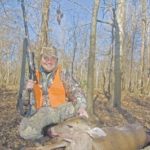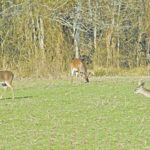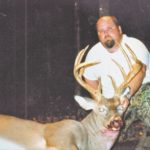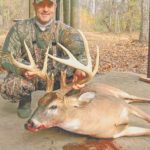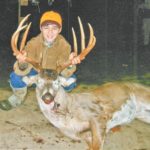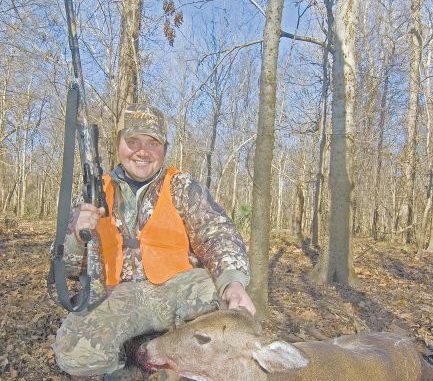
Most hunters recognize deer management as a goal, but only a few are willing to put out the effort necessary to produce trophy deer. This hunting club just across the state line bought into a program at its inception, and now members enjoy unreal hunting.
The opening could be seen through the trees as I eased toward the food plot. When the path made a final turn, I could see the green patch ahead. I slowed down and worked my way around a huge mud hole, easing toward the end of the trail just in case deer had already made it to the food plot.
Sure enough, three deer were feeding on the left side of the field as I peered around the corner of the trees. I eased to my knees, trying to figure out how to get to the stand without messing up the rest of my afternoon hunt.
And then movement directly across the field caught my eye. I looked, and my knees went weak: A tall-racked buck was standing beneath a tree on the edge of the food plot, looking into the woods.
My trigger finger itched as I counted 8 points and estimated a 17-inch inside spread. All I had to do was ease my muzzleloader to my shoulder, wait for the deer to turn just a bit, and it would be a 60-yard chip shot.
But I didn’t even move the gun.
I was on a restricted hunting plan for this late-January trip, meaning I was allowed to shoot only a deer of a lifetime.
It all began about eight hours before, when I met Greg Hackney at his Gonzales home for the ride to his Washington County hunting club.
We had discussed his high standards several days earlier, and I was astounded when he shared his standards for a shooter buck.
“I’m looking for a 6-year-old deer,” Hackney said. “I don’t hunt horns; I’m more interested in age.”
I explained that determining a 4½-year-old buck wouldn’t be a big problem but that I wasn’t sure I’d ever seen a deer as old as he was talking about. I tried my best to weaken the strictures, but it was clear he was going to be stubborn.
“Earlier in the year, you don’t know if a buck is going to survive the rut, so if you kill a younger buck it’s no big deal,” Hackney said. “But I know these deer are going to make it now, and I want to let them grow another year.”
I hoped he would feel sorry for me and eventually cave, but he laid down the law as we drove to the property. And just to be sure I didn’t misunderstand, he clarified how serious he was about shooting very mature bucks.
“Now let me tell you: If my best friend messes up, he won’t be invited back,” the B.A.S.S. professional angler and die-hard hunter said. “He’ll still be my best friend, but he’ll never hunt (on Hackney’s club) again.”
Ironically, a wave of relief washed over me: The last thing I wanted to do was kill a buck that didn’t measure up and ruin any chance of future trips. By taking out 4½-year-old bucks, I figured I was pretty much on a sight-seeing trip. I mean, what were the chances of me seeing many big bucks, anyway? I could pass on young baskets all day long with no problem.
That relief had now turned sour, as I watched one of the biggest 8-pointers I’d ever seen alive just standing there, less than a football field away. While one of my inner voices kept screaming at me to shoot, another voice pointed out the deer aged only about 3½ years old — far from the shooter Hackney mandated.
The buck finally saw something in the woods that piqued its interest, and it bounded away to investigate. The other three deer, which turned out to be young bucks, followed their older brother, and the field was empty.
I eased through the woods to the stand, not wanting to take a step into the food plot.
Within 30 minutes, the parade really began.
Deer after deer stepped out to my left, feeding on the winter wheat in the plot. I glassed them carefully, and was amazed to find that each was a spike.
With more than 15 deer in the plot, the second racked buck of the day stepped out — a basket 8-pointer. It was followed by another 8-point, which was followed by yet a third.
The situation was turning almost comical. I mean, I was watching three racks feeding 200 yards from me, and there was nothing I could do about it. It did help that none of the deer were particularly spectacular.
The number in the plot grew to more than 20 deer within the next few minutes, and I couldn’t find a doe in the bunch. So I sat back and pulled out my camera.
I was shooting photos of one of the 8-points, when I glanced the opposite way and caught a glimpse of a huge-bodied buck bounding away from the far corner. In the two long jumps it made before disappearing into thick underbrush, I had the impression of a massive rack atop the deer’s head, but nothing of which I could be certain.
My eye went back to my camera and the crowd of deer to the left side of the stand. I was shooting images of two of the young bucks, when at the corner of the camera’s viewfinder I saw another deer just inside the trees at the far end of the field.
My mouth sagged when I glanced up from the camera and saw the rack on the deer.
It was massive, stretching well outside the body of the buck. My heart stopped momentarily, and then pounded away at a rate high enough to make me lightheaded.
After a few moments of studying the field, the buck stepped out and calmly began feeding. Six tall main-beam tines stretched upward around a 20-inch frame, and 6- to 8-inch brow tines rounded out the crown of calcium.
My sole trophy, a 16-inch 8-point hanging on my living room wall at home, would have easily fit inside this deer’s head gear.
THIS was the biggest deer I’d seen on the hoof, and it was feeding my way.
I desperately studied the deer’s body, trying to figure out how old it was. It had a deep belly, but the back wasn’t particularly saggy. A thick, muscular neck bulged from behind the deer’s ears and attached its head to a bulky chest.
Four and a half years, easy. I was leaning toward 5½, and trying to convince myself it was 6½.
An hour later, the deer was standing broadside about 40 yards away. By this point, I was studying the buck through my rifle scope and was firmly convinced the deer was at LEAST 5½ years old, MAYBE 6½.
My right forefinger felt like ants were crawling around under skin, and I almost had to put my hand in my pocket to keep that finger away from the trigger.
The deer stayed in the field for more than 2 hours, most of that time spent right in front of the stand at no more than 100 paces. It was maddening.
But Hackney’s warning echoed through my head, keeping me focused and in check.
Darkness finally cloaked the field, and I climbed from the stand with visions of probably my most-exciting hunt still playing in my mind.
Back at the camp, I pulled out my camera and showed Hackney photos of the deer. He wasn’t too impressed.
“It’s still a young deer,” he said. “See how his chest is bigger than his neck? A fully mature deer’s neck will come into its chest and form sort of a block.
“It’s a nice deer, but it’s probably only 4 ½ years old.”
I argued with him, but he wouldn’t budge.
The next morning, Hackney hunted an in-the-woods stand near that same food plot. When he picked me up from my stand mid-morning where I had watched several does and a couple of young bucks cross, he said he had seen several big-racked deer.
“I was on my stand, and I kept hearing deer fighting in a thicket just off that food plot you hunted,” he explained. “I eased over there, and four deer stood up.”
One of them was the deer I had desperately wanted to shoot the evening before.
“It’s a better deer than I thought,” Hackney admitted. “It’s got a lot of mass.”
But he didn’t even consider shooting it.
“It’s still only about 4½ years old,” he said.
It was after the second evening hunt that I realized just how serious Hackney was about letting bucks age.
One of the other members’ sons had arrived earlier with a couple of buddies, and Hackney and I ran into them on our way out of woods from the evening hunt. In the back of their truck, we could see just the tip of a rack sticking up.
It turned out to be a 12-point with maybe a 15-inch inside spread. Nice, but not spectacular, although it did fully satisfy the club’s rules.
Hackney was less than pleased, especially since the deer probably aged out at only 3½ years.
“I can’t believe he killed a deer like that at the end of the season,” he fumed. “That’s the kind of deer that you want to pass up because he would be a monster next year.”
It was an amazing statement because the deer was very nice, even if it wasn’t a monster. But over the three days I spent hunting with Hackney, I came to understand why this hunter felt so strongly.
The property was simply a zoo filled with rack bucks. I never sat the stand without seeing deer, and on all but one of the four hunts I saw at least one rack buck.
On the final hunt of the trip, I watched four 8-pointers feeding in an oak flat. Three of those would have died on most other pieces of property.
And the lines of mounted racks on the wall of the camp, along with albums full of photos of deer kills, gave testament to the potential of the property.
Hunters on the property took 27 bucks last year, and a majority of those were at least 4½ years old. Three of them were 6½-year-old brutes, while seven had reached 5½ years of age before being killed. Another nine were 4½ years old. Only two bucks were 21/2 years old.
Hackney said each of the deer that had reached at least 4½ years of age were great bucks, providing proof of what could be accomplished with determined management.
“We have the genetics and the population to produce really big deer,” Hackney said on the way home. “You’ve just got to let them grow to take that next step.
“I don’t care what you do: A deer isn’t going to get big unless he gets old.”
